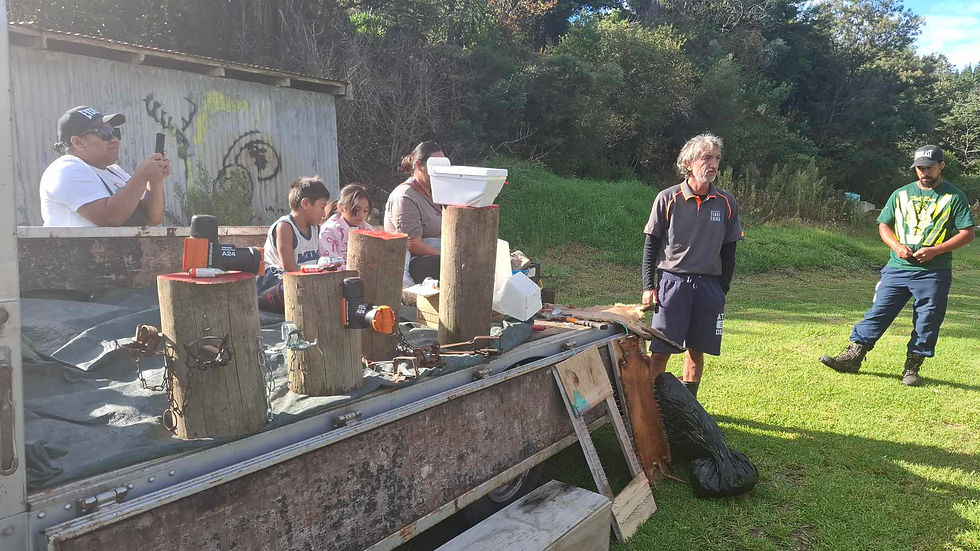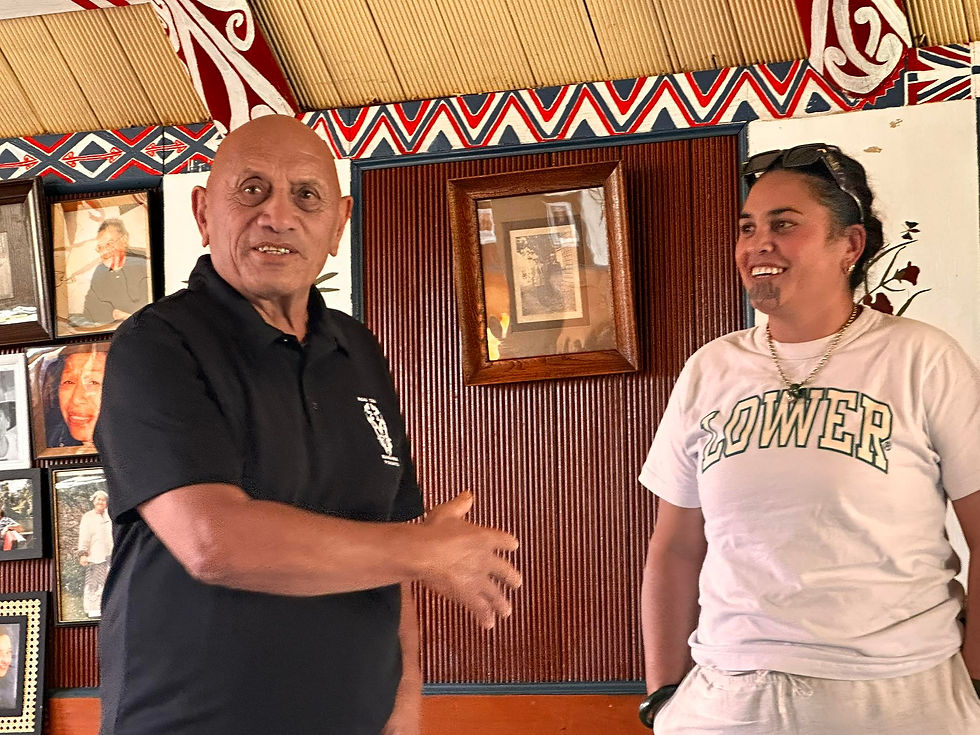Bush Yarns - Exploring Indigenous Ngāti ira Wisdom
- Ngā Kaimahi Whenua
- Apr 1
- 5 min read
Updated: Apr 22

Above gallery images courtesy of Ria Brosnan
A lively and inspiring event unfolded at the Ngāti Ira-led wānanga taiao. This gathering put indigenous wisdom front and centre, organised by Te Kapahaka o Waioweka. It drew conservation advocates, hunters, pakeke, kaumātua, and children—each person eager to learn and share practices about protecting the taiao. Throughout the day, attendees engaged in sessions, heard from inspiring conservation leaders, and enjoyed delicious kai that nourished both body and spirit.
The event kicked off early in the morning at Ōpeke Marae. The buzzing atmosphere was filled with excitement and energy as attendees greeted each other and settled in for the day's kaupapa.

He whenua mokopuna!
A passionate Ngāti Ira warrior, Billy Waugh shared his dedication to protecting our whenua. This was evident in his multifaceted roles as a trapper, environmentalist, hunter, and educator. He employs a variety of pest control methods, including trapping, to eradicate invasive species that threaten native flora and fauna. His work not only preserves biodiversity but also upholds the principles of kaitiakitanga, ensuring that the land remains healthy and productive for our mokopuna, our future generations.

Hao Matamoe
A father and son team Ian & Manawa Ruru from Te Aitanga-a-Māhaki, Ngāti Porou, Ngāi Tai, and Whakatōhea are experts in freshwater management. They focus on the life cycle of tuna (eels), teaching how to identify healthy tuna and their significance as indicators of the mauri (life force) of our waterways. Their work highlights the interconnectedness of all living things and the importance of maintaining the health of our rivers and streams to support both ecological balance and cultural heritage. We remembered the place the matamoe have in our streams and the struggles they are confronted with in trying to thrive in their home waters, our kōawa and awa. The changes over time that have caused our awa to shift its pathway as it navigates itself to the moana (and subsequently our kōawa), the impact of people and their ways of living on the environment and other factors that cause the matamoe to struggle in their natural spaces.

Te honongā a Mātauranga Māori me Pūtaiao
Heni Unwin is a marine scientist who blends Mātauranga Māori (Māori knowledge) with Western scientific practices to protect our marine environments. Her research and business development efforts are crucial in addressing environmental challenges such as pollution, overfishing, and climate change.
By integrating traditional knowledge with modern science, Heni fosters a holistic approach to environmental stewardship that respects and incorporates indigenous perspectives. She draws upon the knowledge of whakapapa, kura huna, pūrākau, and kupu to take us back to the origins of our traditional whenua, awa, roto and moana, and all living things that dwell in and around those spaces.

He whenua tōnui hei whakaora kiwi
Corey Kurei shared his role as a dedicated kaitiaki with a strong focus on Kiwi conservation. His extensive experience with Ngā Whenua Rāhui, an organisation that supports the protection of Māori land, and currently the Department of Conservation (DOC) has equipped him with the skills and knowledge to ensure the survival of the Kiwi using the technology available (Kiwi dog aversion training) to support the Kiwi to thrive and flourish. Corey shared that while this technology is helpful for the survival of the Kiwi, it is not 100% fool-proof. So in addition, Corey also educates whānau on the importance of restoring and maintaining natural habitats, emphasising the role of community involvement in conservation efforts, and animal pest control (namely goats and deer).

Taku ahi kā, taku tuakiritanga
Ngā Kaimahi Whenua o Ngāti Ira are a roopū hapū of dedicated environmental kaitiaki and workers who share their journey and the significant work they have accomplished. Their vision for the future includes continued efforts to restore and protect natural landscapes, promote sustainable practices, and engage with communities to foster a deeper connection to the land. Tawa Kingi shared the extensive efforts she and Ngā Kaimahi Whenua are undertaking to protect and preserve the environment in the Ngāti Ira region. Despite the challenges posed by the surrounding environment, the people of Ngāti Ira remain steadfast in their commitment to achieving positive and sustainable outcomes for their land. Their dedication ensures that the mokopuna (grandchildren) of today and those yet to come will inherit a land they can cultivate and rivers in which they can bathe.

He rautaki marama, he rautaki whānau
Before our dinner, we were guided by the inspirational duo, Uncle Buster and Ashley. They shared their family strategy based on the maramataka (Māori lunar calendar). Navigated by wairua and kōrero tuku iho, they use the maramataka to plan activities such as planting, fishing, and harvesting, ensuring these practices align with natural cycles.
This method not only promotes sustainability but also strengthens cultural identity and connection to the environment. By being immersed in the knowledge that allows us to interpret the guidance of Ranginui, Papatūānuku, and their children, we ensure the preservation of our ancestral narratives, enabling us to live authentically within our indigenous heritage.
Delicious kai
Our day began with a delightful morning tea, featuring freshly baked scones served with rich cream, accompanied by a comforting bowl of pumpkin soup. To complement this, we had a selection of hot beverages, including tea, coffee, and Milo, ensuring everyone had their preferred choice to start the day right.
As lunchtime approached, we enjoyed a variety of delicious subs, offering a satisfying and convenient meal that catered to different tastes and preferences.
For an afternoon snack, we had a refreshing assortment of fresh fruit and delectable slices, providing a perfect balance of health and indulgence to keep us energized throughout the day.
The evening tea was a feast to remember, starting with battered mussels and mussel fritters, showcasing the best of our local seafood. This was followed by a hearty roast, featuring succulent chicken and pork, served with rich gravy and a medley of roast vegetables. To round off the meal, we indulged in two delightful desserts: creamy rice pudding and a decadent Black Forest pudding, leaving everyone with a sweet and satisfying end to the day.

Lasting Lessons
The Māori-led community learning wānanga was much more than a series of talks and workshops; it provided a rich experience rooted in indigenous principles that can influence future conservation advocacy. The lessons learned and connections formed during this event will leave a lasting impression on all who attended.
Indigenous wisdom offers crucial perspectives on sustainability and conservation. It emphasizes the necessity of community engagement and active stewardship of the land. As we confront various global environmental challenges, integrating these principles can be transformative in promoting a healthier planet for generations to come.
In summary, the hapū-led community learning wānanga stood as a powerful tribute to the enduring relevance of indigenous knowledge. As Hunter Gatherers, the uncles, aunties, and cuzzies of Waiōweka Gorge live the traditional kohi kai lifestyle. They shared stories about their experiences as hunter-gatherers, providing insights into the sustainable practices that have been passed down through generations. Their narratives emphasize the importance of living in harmony with nature and the value of traditional knowledge in maintaining ecological balance. Participants emerged not only with a deeper understanding of conservation but also with a strong sense of belonging to a collective effort dedicated to environmental preservation. The collaborative spirit and cultural richness experienced at this gathering will continue to inspire and drive conservation initiatives long after the event has concluded.
These gatherings highlight the profound relationship between environmental protection and cultural heritage, showcasing the invaluable contributions of our kaitiaki taiao and their commitment to preserving both the natural world and their cultural traditions.















Comments